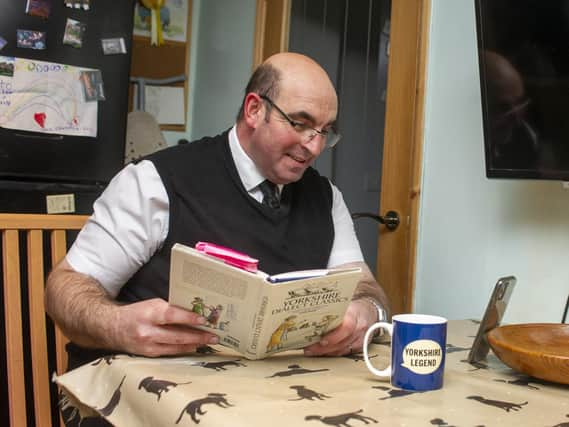North York Moors dialect changes every eight miles, says expert


It is a career which has seen the Nawton born and raised funeral director, raise hundreds of thousands of pounds for charities like Yorkshire Air Ambulance and St Catherine’s Hospice.
In pre-Covid years he is much in demand as an after-dinner speaker or for Women’s Institute, Yorkshire Countrywomen’s Association, National Farmers’ Union and village hall events. He also plays to packed houses at the Kirk Theatre in Pickering every year. “I’ve had to change with the times since March,” said Adam, who during the day runs his own independent funeral directors, a business which he said had also seen enormous change over the past ten months.
Advertisement
Hide AdAdvertisement
Hide Ad“For the past 25 years, I have been out three or four times a week during spring and summer, reciting poems and recounting stories that involve the Yorkshire dialect and its people.
“But since last year’s first lockdown in March, I have created a series of videos through Facebook that have had audiences of more than 5,000 and have been watched around the world.”
Adam said his first dabble in the world of dialect poetry came when he was seven-years-old as part of a troupe reciting Marriott Edgar’s The Lion & Albert poem made famous by Stanley Holloway in the 1930s. But it was three years later in Wombleton Village Hall his interest in Yorkshire dialect began to grow.
“The poem I’d been asked to recite was called Goodies by Walter F Turner from Fridaythorpe, up on the Yorkshire Wolds,” said Adam.
Advertisement
Hide AdAdvertisement
Hide Ad“I then got hold of a book that included more, called Goodies and other stories in Yorkshire Dialect which was first published in 1912.
“I found other books too, by people like Arnold Kellett who was from Wibsey near Bradford originally but settled in Knaresborough.
“My fascination then took greater hold and I began to realise that every eight miles or so there is a change in the dialect.
“For instance, it is a very different dialect in Farndale, much broader than Helmsley.
Advertisement
Hide AdAdvertisement
Hide Ad“Anyone who listens to my good friend sheep farmer Andy Fawbert when he’s in the Feversham Arms in Church Houses will tell you just how broad and unrecognisable it can sometimes be.”
Listening to different regional accents has long been a favourite of many pub goers and Adam said his grandfather Ernest along with his friends always entertained a crowd, even if they didn’t quite know why.
“Sometimes it is frowned upon, speaking in Yorkshire dialect, but other times people just love it.
“I’ve seen people come into our local, the Rose & Crown in Nawton, just to listen to my grandad and his mates playing dominoes. People generally enjoy hearing the accent and the way they speak.”
Advertisement
Hide AdAdvertisement
Hide AdAdam has his theory as to why individual areas developed their own verbal identity over many years.
“Stape, in the North York Moors, has a completely unique dialect probably on account of its community, years ago, not travelling far. But the dialect of the North Riding isn’t far removed from that of Holderness and the East Riding. They are both however quite different to the West Riding dialect.”
Adam said he finds words used in dialect can often have several meanings. He also recounts the old ways of counting sheep on the moors.
“One word can often mean three of four different things,” he explained. “Like clowt, for instance.
Advertisement
Hide AdAdvertisement
Hide Ad“It can mean a piece of cloth in some talk; it can mean a smack; or it can mean how much brainpower you have, but they are all still the same word.
“Sheep counting went like this: Yah (one); Tear (two) pronounced tier; Tether (three); Mether (four); and Pip (five). It only went up to 20 in the old scoring system and had much to do with being quick as sheep were transferred from one field to another.”
Around a decade ago Adam added commentary to his repertoire - not in Yorkshire dialect - taking over from Bill Hebron at Rosedale Show.
He now also commentates at Bilsdale and Farndale.
“The then Rosedale Show secretary, Janet Dring, asked whether I’d do it one afternoon when the person who had taken over from Bill could only do the morning session.
Advertisement
Hide AdAdvertisement
Hide Ad“I’ve been doing it ever since, but not in Yorkshire dialect.”
Adam’s other interest has always been rabbits and guinea pigs. His neighbour Barney Kent had show stock and the young Adam would go with Barney to the shows with his own stock.
“Barney left me all his rabbits and guinea pigs when he died, but I couldn’t look after them all.
“He had 100 rabbits and 80 guinea pigs and I was only 11 at the time.
Advertisement
Hide AdAdvertisement
Hide Ad“I kept 12 of each. I now have 22 rabbits and 100 guinea pigs and still show them. I also have goats and some sheep.”
But along with his Yorkshire dialect, Adam said he knew from the age of 13 where his future lay.
“I remember seeing a hearse go past and thinking I could do that,” he said.
“When I told my careers adviser he looked at me with such a blank expression, but I just knew it was something where I could help people and I knew I wasn’t clever enough to be a doctor or a vet.”
Advertisement
Hide AdAdvertisement
Hide AdHe set up Adam Collier Funeral Services in 2012 and runs it with his family, wife Stephanie, parents Diane and Richard and brother-in-law Brodie.
“It’s a real family business, which is what people like round here.
But, he said, the past year has been a “learning curve”.
“The Covid arrangements have made funerals so different and although we still have a lot of church services, being in a rural area, there has been a shift to going straight to the crematorium,” he said.